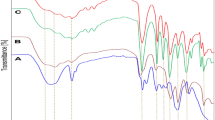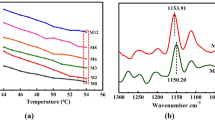Abstract
Amine-containing polysilsesquioxane (PSQ) membranes were studied with regard to their CO2 separation ability. PSQ membranes were prepared by the sol–gel process using three amine-containing monomers, bis(triethoxysilylpropyl)amine (BTESPA), (aminopropyl)triethoxysilane (APTES), and (aminoethylaminopropyl)triethoxysilane (AEAPTES), to examine the relationship between precursor structure and membrane performance. The CO2 permeances of the membranes prepared by 1:1 copolymerization with bis(triethoxysilyl)ethane increased in the order of AEAPTES-derived membranes < APTES-derived membranes < BTESPA-derived membranes, and their CO2/N2 permselectivities decreased in the same order. On the basis of density functional theory calculations on model systems and nitrogen adsorption-desorption experiments of the PSQ gels, it was found that CO2 affinity and porosity of the membranes were important factors affecting CO2 separation performance. Copolymerization under acidic conditions resulted in the formation of ammonium-containing membranes with improved CO2 permeances and acceptable CO2/N2 permselectivities.
This is a preview of subscription content, access via your institution
Access options
Subscribe to this journal
Receive 12 print issues and online access
$259.00 per year
only $21.58 per issue
Buy this article
- Purchase on Springer Link
- Instant access to full article PDF
Prices may be subject to local taxes which are calculated during checkout








Similar content being viewed by others
References
Robeson LM. The upper bound revisited. J Membr Sci. 2008;320:390–400.
Brunetti A, Scura F, Barbieri G, Drioli E. Membrane technologies for CO2 separation. J Membr Sci. 2010;359:115–25.
Ma C, Wang M, Wang Z, Gao M, Wang J. Recent progress on thin film composite membranes for CO2 separation. J CO2 Utilization. 2020;42:101296.
Yu L, Kanezashi M, Nagasawa H, Tsuru T. Role of amine type in CO2 separation performance within amine functionalized silica/organosilica membranes: a review. Appl Sci. 2018;8:1032.
Yu L, Kanezashi M, Nagasawa H, Tsuru T. Fabrication and CO2 permeation properties of amine-silica membranes using a variety of amine types. J Membr Sci. 2017;541:447–56.
Yu L, Kanezashi M, Nagasawa H, Moriyama N, Tsuru T, Ito K. Enhanced CO2 separation performance for tertiary amine-silica membranes via thermally induced local liberation of CH3Cl. AIChE J. 2018;64:1528–39.
Yu L, Kanezashi M, Nagasawa H, Oshita J, Naka A, Tsuru T. Pyrimidine-bridged organoalkoxysilane membrane for high-efficiency CO2 transport via mild affinity. Sep Purif Technol 2017;178:232–41.
Xomeriakis G, Tsai CY, Brnker CJ. Microporous sol–gel derived aminosilicate membrane for enhanced carbon dioxide separation. Sep Purif Technol. 2005;42:249–57.
Guo M, Kanazashi M, Nagasawa H, Yu L, Ohshita J, Tsuru T. Amino-decorated organosilica membranes for highly permeable CO2 capture. J Membr Sci. 2020;611:118328.
Paradis GG, Kreiter R, van Tuel MM, Nijmeijer A, Vente JF. Amino-functionalized microporous hybrid silica membranes. J Mater Chem. 2012;22:7258–64.
Xiu R, Kanezashi M, Guo M, Xu R, Zhong J, Tsuru T. Multiple amine-contained POSS-functionalized organosilica membranes for gas separation. Membranes. 2021;11:194.
Kang WR, Lee AS, Park S, Park SH, Baek KY, Lee KB, et al. Free-standing polysilsesquioxane-based inorganic/organic hybrid membranes for gas separations. J Membr Sci. 2015;475:384–94.
Karimi S, Mortazavi Y, Khodadadi AA, Holmgren A, Korelskiy D, Hedlund J. Functionalization of silica membranes for CO2 separation. Sep Purif Technol. 2020;235:116207.
Kaneko Y, Iyi N, Matsumoto T, Kitamura K. Synthesis of rodlike polysiloxane with hexagonal phase by sol–gel reaction of organotrialkoxysilane monomer containing two amino groups. Polymer. 2005;46:1828–33.
Anggarini U, Yu L, Nagasawa H, Kanezashi M, Tsuru T. Metal-induced microporous aminosilica creates a highly permeable gas-separation membrane. Mater Chem Front. 2021;5:3029.
Yamamoto K, Koge S, Sasahara K, Mizumo T, Kaneko Y, Kanezashi M, et al. Preparation of bridged polysilsesquioxane membranes from bis[3-(triethoxysilyl)propyl]amine for water desalination. Bull Chem Soc Jpn. 2017;90:1035–40.
Zheng FT, Yamamoto K, Kanezashi M, Gunji T, Tsuru T, Ohshita J. Preparation of hybrid organosilica reverse osmosis membranes by interfacial polymerization of Bis[(trialkoxysilyl)propyl]amine. Chem Lett. 2018;47:1210–2.
Tsuru T, Nakasuji T, Oka M, Kanezashi M, Yoshioka T. Preparation of hydrophobic nanoporous methylated SiO2 membranes and application to nanofiltration of hexane solutions. J Membr Sci. 2011;384:149–56.
Xu R, Wang JH, Kanezashi M, Yoshioka T, Tsuru T. Reverse osmosis performance of organosilica membranes and comparison with the pervaporation and gas permeation properties. AIChE J. 2013;59:1298–307.
Xu R, Ibrahim SM, Kanezashi M, Yoshioka T, Ito K, Ohshita J, et al. New insights into the microstructure-separation properties of organosilica membranes with ethane, ethylene, and acetylene bridges. ACS Appl Mater Interfaces. 2014;6:9357–64.
Villaluenga JPG, Seoane B. Experimental estimation of gas-transport properties of linear low-density polyethylene membranes by an integral permeation method. J Appl Polym Sci. 2001;82:3013–21.
Author information
Authors and Affiliations
Corresponding authors
Ethics declarations
Conflict of interest
The authors declare no competing interests.
Additional information
Publisher’s note Springer Nature remains neutral with regard to jurisdictional claims in published maps and institutional affiliations.
Supplementary information
Rights and permissions
About this article
Cite this article
Ohshita, J., Okonogi, T., Kajimura, K. et al. Preparation of amine- and ammonium-containing polysilsesquioxane membranes for CO2 separation. Polym J 54, 875–882 (2022). https://doi.org/10.1038/s41428-022-00635-x
Received:
Revised:
Accepted:
Published:
Issue Date:
DOI: https://doi.org/10.1038/s41428-022-00635-x



